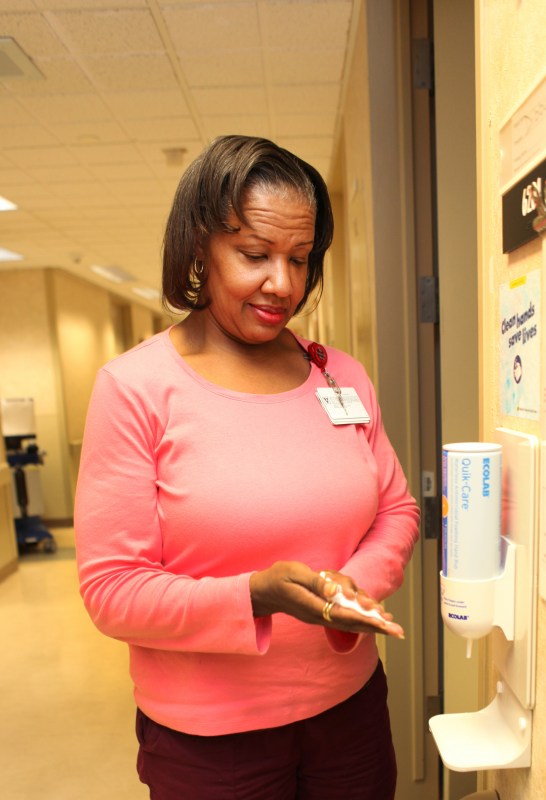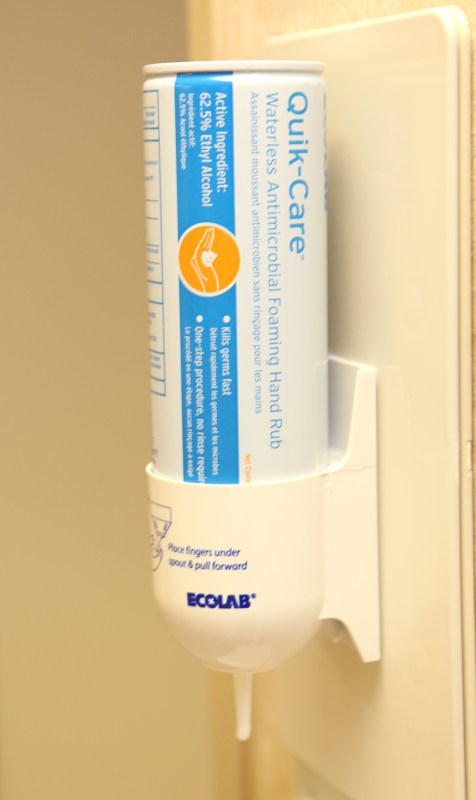
Edna Wilson, who works on 6 South of VUH, keeps tabs on hand hygiene compliance in her area. (Photo by Susan Urmy)
Hand-washing program lathers up success

Hand washing compliance rates are on the rise. (Photo by Susan Urmy)
And Vanderbilt University Medical Center's chief hospital epidemiologist, Tom Talbot, M.D., MPH, couldn't be more pleased.
The buzz words for the hospital-wide hand-washing program, “foam in, foam out,” have caught on. Adhering to proper hand hygiene practices is critical in enhancing patient safety by reducing rates of hospital-acquired infections.
Since the launch of the hand-hygiene campaign in 2009, compliance rates have soared, said Talbot. He credits the program's success to the creation of observation teams that evaluate faculty and staff compliance of hand-hygiene practices as well as to an increase in accountability of the standardized practice throughout the hospital.
“We have a model of shared responsibility that goes all the way up the chain of command,” said Talbot. “Units are sharing information, staff are more engaged and an increasing number have been trained to speak up when they see noncompliant behaviors.
“It's all about ownership,” he said. “If you ingrain habits and a specific culture into people, they will just perform that task without even thinking about it. That's the goal. And we are doing a great job of moving toward that.”
At the start of the campaign in 2009, Talbot said the Medical Center had a 58 percent compliance rate. Now, two years later, the rates are approaching the 90th percentile and the number of observations has reached more than 50,000.
“We continually make enhancements to the program because we are always seeking improvement,” he added. “There has been a marked engagement from leadership to change our hand-hygiene practices, and you can, slowly but surely, see a definite culture change, unit by unit.”
The most recent change has been the use of a “score card” that compares performance among every unit within the Medical Center. The one-page document includes graphs that show a unit-by-unit comparison of hand-washing data, performance to date information and a breakdown of hand washing by role (nursing, physician, other).
For the past few months, the cardiac short stay/intervention unit on 6 South in VUH has been the leader of the pack, with 93 percent for the year and 100 percent compliance for the months of March and April.
“They have a really strong team. They are really good at holding each other accountable because they are pretty aggressive on the floor,” said Janice Gabbard, MSN, R.N., nurse manager for the unit. “And they have Edna!”
Edna Wilson, aka the “hand-washing police,” is the medical receptionist on 6 South. She is perfectly positioned to be the eyes of the unit and is well known for her attention to infection control.
“Edna drives their enthusiasm,” said Gabbard. “She is not intimidated by the person, the title or the position. She wants what is best for the patient and if that means reminding everyone to foam in and foam out, she does it.”
In 2007, Wilson received the Infection Prevention Award while working on 8 South, the Medical Surgery floor.
“I'm so vigilant because I know what I am doing is protecting patients and co-workers,” said Wilson. “I am really proud of our floor and the role that I play in helping maintain a high compliance rate, but it's really everyone's job. And we all take it very seriously.”
Units and departments have created their own slogans to promote the campaign and alert staff to the overall message: clean hands save lives.
“We love that people are owning it and doing their own thing to move the needle,” said Talbot. “It encourages everyone to work together on a shared problem. It has had a positive impact on the hospital as a whole.
“This has been a very fascinating experience because of the potential for transformation. It is more than just washing our hands. Infection rates are dropping and we are seeing improvement across the board on many safety issues.”
Talbot highlighted the continued success of the Monroe Carell Jr Children's Hospital at Vanderbilt. In April, Children's Hospital was at 90 percent compliance overall. When the program was first initiated, the hospital was assessed at 52 percent.
There are about 200 trained observers throughout the Medical Center in addition to the pool of management-level volunteers who are assigned specific units to track compliance rates. They perform about 20 observations a month. Recently, all Department of Anesthesia faculty were educated on the observation requirements. It is the first large physician group to do so.













